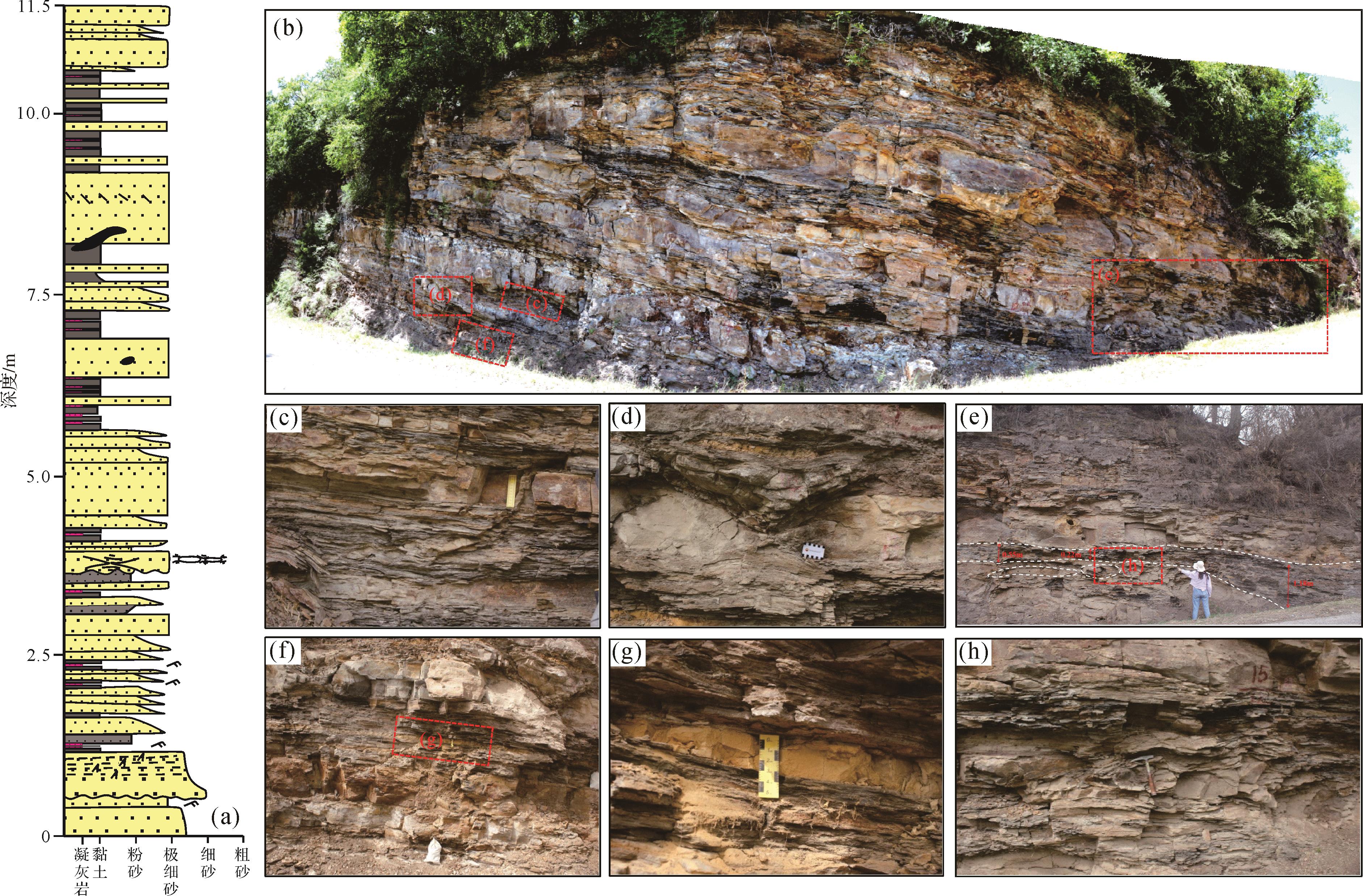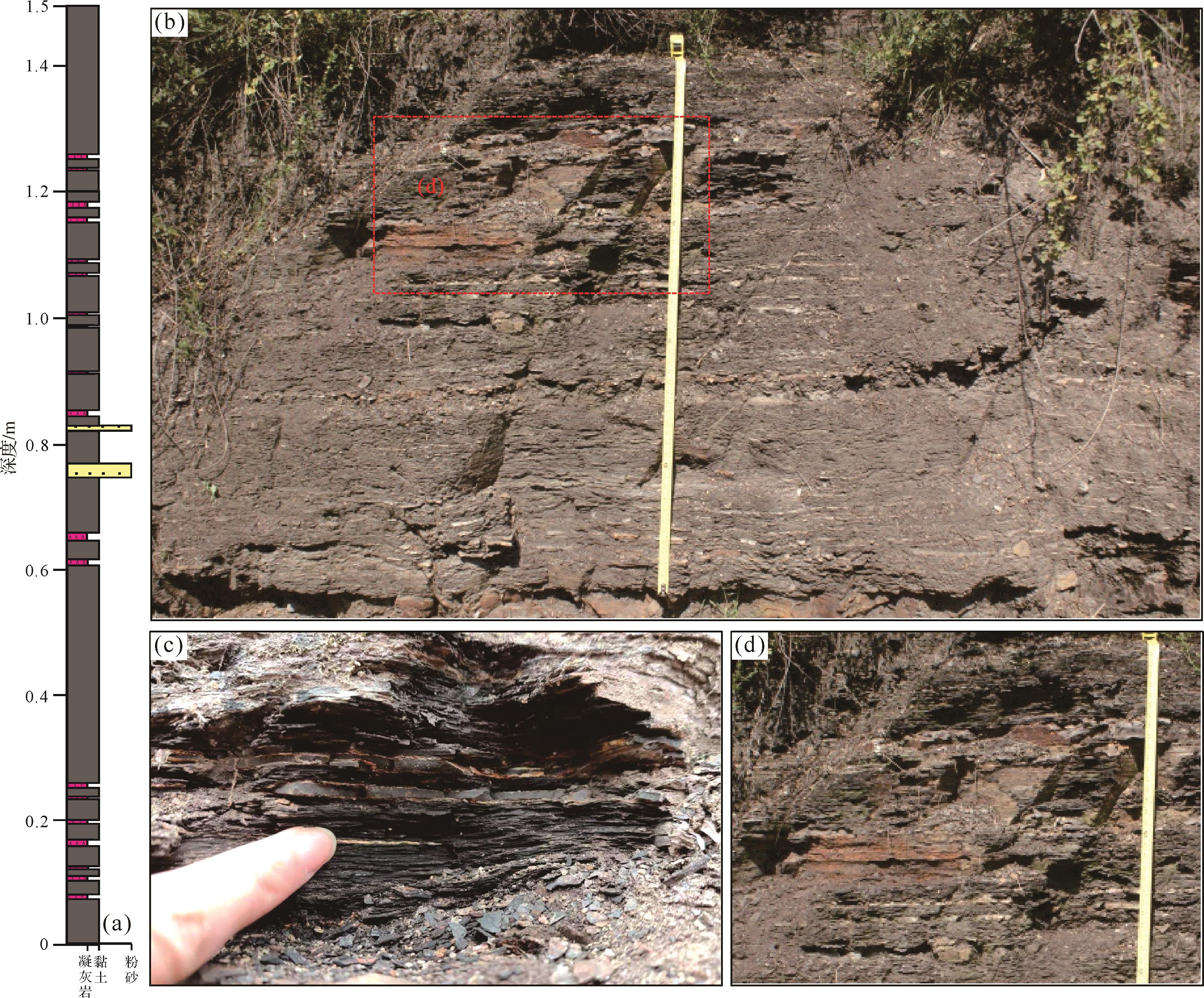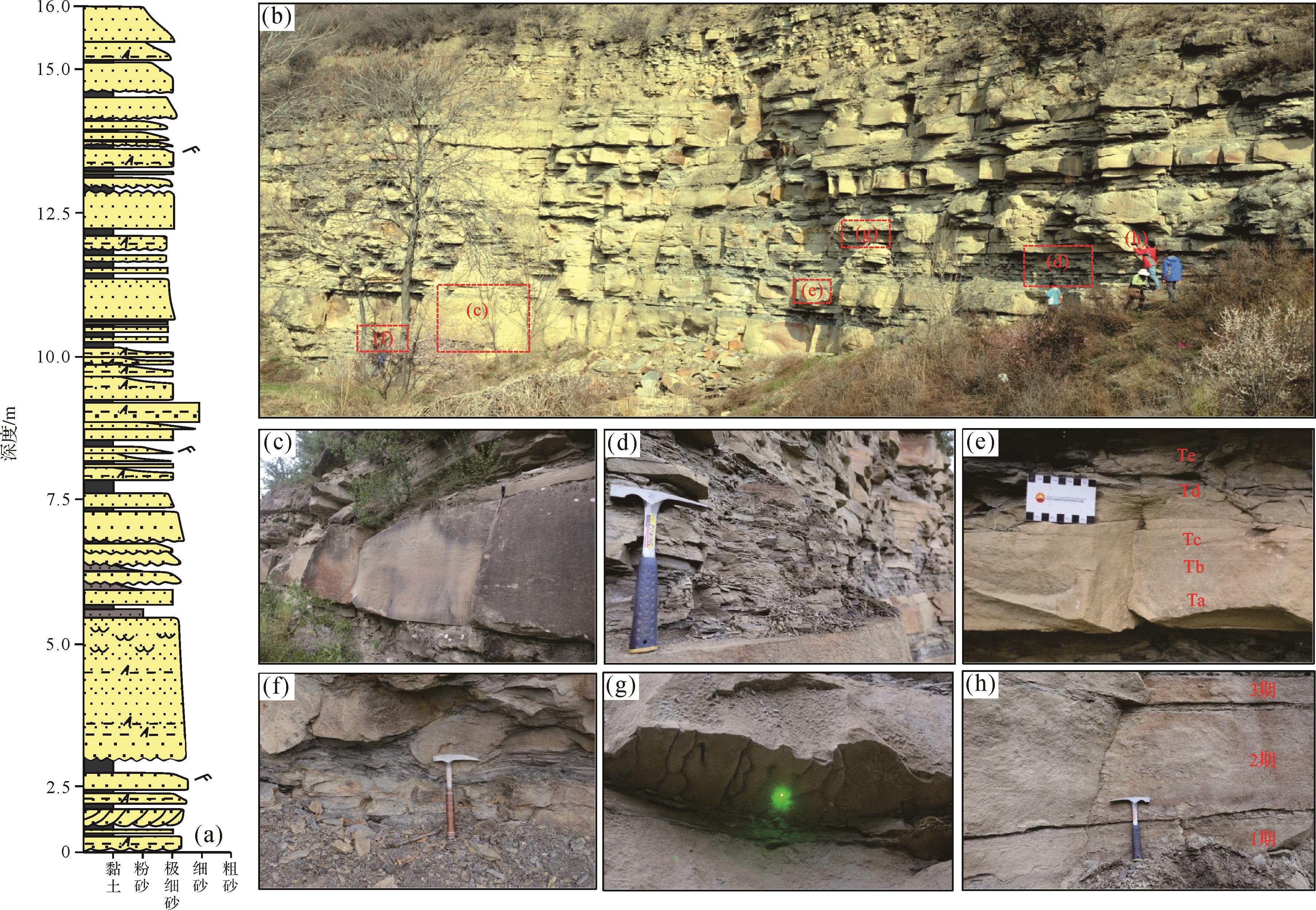HTML
-
随着常规油气勘探开发程度的不断提高,非常规油气逐渐成为现阶段油气勘探开发的重点目标[1]。其中,陆相页岩油作为重要的非常规油气资源受到持续关注[1⁃2]。鄂尔多斯盆地延长组长7油层组作为中国湖相页岩油的典型代表,以往的学者针对其沉积特征、储集空间类型及含油性开展了大量研究[3⁃5]。长7油层组整体以细粒沉积为主,以富有机质泥页岩夹薄层细砂岩、粉砂岩为主要沉积特征,其中发育的细砂岩、粉砂岩对油气的富集起着明显的控制作用[5]。一般来说,细粒沉积岩指沉积物粒径小于62.5 μm的颗粒含量大于50%的沉积岩,主要由黏土和粉砂等碎屑颗粒组成,包含少量盆内生产的碳酸盐、生物硅质、磷酸盐等。细粒沉积岩系统指细粒沉积岩含量大于50%或细粒沉积物厚度占总沉积厚度的70%的细粒沉积系统。而细粒沉积岩系统中的薄层细砂岩、粉砂岩沉积成因的研究具有重要的油气地质意义[3⁃5]。早期研究认为主要为浊流沉积成因[6];随后的研究认为深水泥页岩中的薄层细砂岩与粉砂岩主要为砂质碎屑流和低密度浊流沉积成因,并且以砂质碎屑流沉积为主[3⁃4,7⁃8]。此外,还有部分研究认为深水泥页岩中的薄层细砂岩与粉砂岩还包含部分的风暴岩和风暴浊积岩[9]。
整体上看,对于深水泥页岩中的薄层细砂岩与粉砂岩隶属重力流成因砂体已基本达成共识[3⁃4,7⁃8]。近年来,关于重力流的流体分类及其动力学过程研究取得了瞩目的成果,基于砂质碎屑流和异重流等流体类型的认识,丰富了对陆相湖盆重力流流体类型的理解[10⁃11];三角洲再搬运和洪水持续供给并存的重力流成因机制认识,揭示了湖相重力流砂体广泛发育的本质[12⁃14];重力流水道控制及砂质碎屑流块体主导的不同沉积模式研究,深化了湖相重力流砂体分布规律及内幕结构的认识[10,15]。针对湖盆深水泥岩中的薄层细砂岩和粉砂岩沉积成因,除了已有的浊流与砂质碎屑流沉积成因认识,现阶段的研究表明异重流、滑动滑塌沉积可能发挥了更为明显的控制作用[16⁃18]。目前,针对长7油层组富有机质泥页岩中薄层细砂岩、粉砂岩的沉积成因系统研究还十分匮乏。如何有效识别和区分不同重力流作用机制下形成的薄层细砂岩、粉砂岩沉积亟需系统攻关研究[19⁃22]。
为了解决上述问题,本文以鄂尔多斯盆地南部出露较好的延长组长7油层组深水沉积露头为研究对象,重点分析各露头沉积物组成、典型沉积构造、岩相及岩相组合特征,总结沉积相类型及空间展布特征,建立不同岩相中细粒沉积物的发育模式,以期为鄂尔多斯盆地南部地区常规及非常规油气资源的勘探开发及大型坳陷湖盆深水细粒沉积成因机理研究提供借鉴。
-
鄂尔多斯盆地是中国第二大含油气盆地,横跨陕、甘、宁、蒙及晋五省(图1a,b),大地构造处于中国东部构造域与西部构造域接合部位,古生代时属大华北盆地的一部分,中生代后期晚三叠世发生的印支运动使扬子板块北缘与华北板块发生挤压碰撞,在盆山耦合作用下,形成了鄂尔多斯大型内陆坳陷湖盆。构造区带划分为西缘逆冲带、天环坳陷、伊陕斜坡、晋西挠褶带、伊盟隆起和渭北隆起六个单元[23]。
晚三叠世延长期,华北陆块和扬子板块相撞,受秦岭造山活动影响,发育一套大型坳陷盆地背景下的河流—三角洲—湖泊相碎屑岩沉积[7],延长组自上而下可分为10个油层组(长1—长10)。其中,长7油层组沉积期,盆地周缘区域构造较活跃,盆地受西南方向强烈挤压和东北方向垂向隆升的影响,发生了南北不均衡、不对称的快速坳陷过程,湖盆基底呈“南陡北缓”的展布格局[24]。同时,长7油层组沉积期也是湖盆最大的扩张期,湖水深、水域分布广,形成了面积达6.5×104 km2的半深湖—深湖区,发育一套以暗色泥岩、黑色页岩为主、厚度达100 m的富有机质生油岩系,从而奠定了中生代陆相湖盆生油的资源基础[23]。盆地南缘铜川地区出露了大量的长7油层组深水细粒沉积露头,包括衣食村剖面长72和长73亚油层组、瑶曲剖面长71亚油层组等,为系统地研究深水细粒沉积特征及其成因提供了良好的条件(图1c)。
-
根据不同剖面物质组成特征、典型沉积构造、上下地层接触关系,明确了铜川地区发育的典型沉积剖面的地层归属。衣食村剖面下部为长73亚油层组沉积产物,其底部与长81亚段的三角洲沉积相接触(图2)。三角洲沉积整体以中细砂岩沉积为主,砂体以透镜状几何形态为典型特征,不同厚度的沉积砂体中可见典型的牵引流沉积形成的槽状交错层理、平行层理等沉积构造。衣食村剖面下部长73亚油层组沉积以少量中厚层块状砂岩与中薄层页岩互层沉积为典型特征,砂岩中多发育块状砂岩,为砂质碎屑流沉积产物(图2e);宏观上变形构造发育,可见明显的地层拉张变形,局部可见软沉积布丁构造和滑塌褶皱。衣食村剖面中部为长72亚油层组沉积产物,长72亚油层组与长73亚油层组之间以薄层页岩和凝灰岩层的高频发育为层依据。长72亚油层组以书页状黑色页岩垂向叠置形成厚度较大的稳定页岩沉积为典型特征(图2d),黑色页岩中薄层的火山灰发育,且出现的频率较高,局部发育少量薄层粉细砂岩沉积,为低密度浊流沉积产物(图2d)。衣食村剖面上部为植物覆盖,不便于测量,因而未对其进行量化分析。瑶曲剖面对应为长71亚油层组和长72亚油层组上部沉积,其中长71亚油层组以厚层块状砂岩垂向叠置为典型特征,内部夹少量的浅灰色泥质沉积(图2b);单砂层的厚度从下至上逐渐减小,底部为典型的砂质碎屑流沉积形成的块状砂岩[3],上部过渡为低密度浊流沉积形成的典型正粒序发育砂岩沉积。长72亚油层组上部主要以薄层页岩和薄层粉砂岩互层分布为特征(图2c)。长71亚油层组顶部与长6油层组相接,长6油层组主要为三角洲前缘沉积而区别于长71亚油层组。
-
根据铜川地区延长组长7油层组剖面出露岩石的颜色、粒度、成分及沉积构造等岩石学特征,对露头剖面精细测量描述,以沉积物物质组成和沉积物粒度为依据,结合沉积构造和典型垂向组合序列,将研究区的细粒沉积划分为6种岩相类型:叠覆冲刷正粒序粉砂—细砂岩相(Sa)、块状层理粉砂—细砂岩相(Sm)、软沉积变形砂泥岩混杂相(SMd)、块状泥岩相(Mm)、水平纹层泥页岩相(MSh)和凝灰岩相(T)(图3)。

Figure 3. Typical lithofacies outcrops of fine⁃grained sediments from the Chang 7 oil member in the Tongchuan area
(1) 叠覆冲刷正粒序粉砂—细砂岩相(Sa)。主要发育在长71亚油层组,出现频率高,为多套黄褐色、灰白色泥质粉砂—细砂岩垂向叠置(图3a,j,k)。冲刷面为不同期次Sa相砂岩的接触面,产状多显轻微起伏,通常被泥质沉积分隔,部分冲刷面可见结核。冲刷面上下砂体粒序层理、平行层理及顶部砂纹层理发育,植物碎片丰富,可见漂浮泥砾。砂体底部常见槽模、沟模等底模构造。
(2) 块状层理粉砂—细砂岩相(Sm)。该岩相在研究区内长7油层组中均有出露,其中长71亚油层组最为发育。主要为分选较好的灰色、棕灰色块状层理粉砂—细砂岩,垂向上粒序变化不明显,泥质含量低(图3b)。砂岩与顶底岩层呈突变接触,底面水平,未见底模构造(图3b)。砂体中下部可见呈悬浮状态的泥砾和泥岩撕裂屑(图3b)。
(3) 软沉积变形砂泥岩混杂相(SMd)。主要发育于长71亚油层组底部,以砂泥岩混杂为主要特征,内部不仅常见砂岩液化、揉皱、球枕构造和火焰状构造等同生变形构造(图3f),还可见砂泥岩滑动塑性变形以及悬浮状态定向排列的砂、泥质团块。
(4) 块状泥岩相(Mm)。该岩相以长71亚油层组衣食村剖面及瑶曲剖面中上部的长71亚油层组顶部的特征最为明显。主要为黑色、深灰色块状泥岩—粉砂质泥岩,呈块状,层理构造不发育(图3i)。
(5) 水平纹层泥页岩相(MSh)。研究区露头各层段中均有发育,根据沉积物颜色及页理发育程度可分为水平纹层泥岩相和水平纹层页岩相。水平纹层泥岩相颜色呈黑色、深灰色,为具有水平纹层的泥岩—粉砂质泥岩,与薄层凝灰岩及薄层粉砂岩互层分布(图3h)。岩层横向分布稳定,有时可见变形构造以及呈透镜体形态分布于砂岩层内。水平纹层页岩相主要发育于长72亚油层组,在衣食村剖面以夹层和厚度小于2 m的薄层出露,累计出露厚度超过10 m。新鲜面呈黑色、黑灰色,不污手,火烧后有明显油味。页岩层系内夹薄层凝灰岩,以水平页理为主要特征(图3c,e,g)。自长72亚油层组下部至顶部,页理发育程度随颜色变浅而降低。
(6) 凝灰岩相(T)。研究区凝灰岩呈1~25 cm的夹层产出,产状水平,凝灰岩层的厚度集中在5 cm以下,在长7油层组各亚油层组中均有分布,其中以长7油层组中下部最为发育。薄层凝灰岩主要分布于衣食村剖面,与暗色泥页岩、泥质粉砂岩以及粉砂岩互层分布(图3d,g,j)。颜色呈土黄色、棕褐色,产状水平且横向分布稳定。凝灰岩相主要为灰白色和土黄色,同生变形构造强烈,存在滑塌、揉皱现象。根据凝灰岩中凝灰质含量、厚度、颜色以及邻近岩层的岩性等特征,可将凝灰岩相进一步分为风携型凝灰岩相(Td)与再沉积型凝灰岩相(Trd)两种亚类。
-
在岩相沉积特征分析的基础上,综合分析总结铜川地区长7油层组细粒沉积的岩相组合类型,垂向上识别出3类共9种岩相组合类型。
(1) 背景泥质沉积、凝灰岩与重力流沉积的垂向组合(LA1)。该岩相组合具体表现为:深水原地沉积背景下的再沉积型凝灰岩(Trd)与重力流砂体的叠置(LA1-1),为中—低凝灰质含量的凝灰岩与重力流砂体的垂向组合(图4a)。空携型凝灰岩(Td)和再沉积型凝灰岩(Trd)与水平纹层泥页岩相(MSh)的垂向叠置(LA1-2),表现为薄层稳定产状产出的空携型Td相和厚层变形的再沉积型Trd相与MSh相的垂向组合(图4b)。水平纹层泥页岩相(MSh)、中薄层块状粉砂岩相(Sm)与薄层的空携型凝灰岩相(Td)在垂向的交替发育(LA1-3),表现为深湖相黑色页岩与未经牵引流改造的空携型凝灰岩的薄互层(图4e)。中薄层块状粉砂岩相(Sm)与块状泥岩(Mm)垂向上互层叠置(LA1-4)(图4c),粉砂岩以正粒序为主,底部可见微弱的侵蚀作用,整体为沉积远端能量较弱的低密度浊流沉积,是远端深水沉积环境的产物。受重力流沉积演化过程及沉积相带的综合控制,随着向深水盆地搬运距离的增加,依次发育LA1-4、LA1-3、LA1-2、LA1-1四类岩相组合。

Figure 4. Fine⁃grained sedimentary lithofacies assemblages from the Chang 7 oil member in the Tongchuan area
(2) 滑动滑塌与背景泥岩互层叠置(LA2)。该岩相组合以整体砂泥混杂为典型特征,单层厚度跨度大,数十厘米和数米尺度均有发育,内部软沉积物变形构造和相对大尺度的滑塌褶皱发育,底部可见微弱的剪切带(图4d),指示整体塑性块状搬运特征。
(3) 重力流沉积砂岩、泥岩垂向叠置(LA3)。该岩相组合具有4种表现形式:叠覆冲刷正粒序粉砂—细砂岩相(Sa)与块状泥岩相(Mm)或与水平纹层泥页岩相(MSh)的垂向组合(LA3-1)。多期浊流事件之间被深水原地沉积分隔,浊流沉积物通常较薄,形成的叠覆冲刷递变层组合厚度小(图4f)。块状层理粉砂—细砂岩相(Sm)与叠覆冲刷正粒序粉砂—细砂岩相(Sa)垂向交替发育(LA3-2),Sm和Sa岩相被上覆、下伏的Mm或MSh岩相分割。主要为多期砂质碎屑流、浊流与深水原地沉积的交替发育(图4g)。块状层理粉砂—细砂岩相(Sm)的多期叠置,水平纹层泥岩—粉砂质泥页岩相(MSh)或夹于不同期次块状层理粉砂—细砂岩相之间(LA3-3)。主要为深水原地沉积与不同期次砂质碎屑流的垂向叠置(图4h)。水平纹层泥页岩相(MSh)与厚层反序砂岩和薄层正序砂岩的垂向叠置(LA3-4),表现为重力流水道中的砂质沉积与泥质沉积垂向叠置(图4i)。综合考虑重力流事件的规模、期次及其在平面上的展布特征,上述4种重力流特征的岩相组合在时间、空间尺度上具有一定的联系和可对比关系。主要有如下特征:单期次重力流从沉积近端到沉积远端,砂体厚度减薄,且滑塌体和砂质碎屑流砂体多为沉积近端沉积产物,而浊流砂体为沉积远端沉积产物。沿着沉积物搬运方向,砂质碎屑流向浊流转化。重力流砂体厚度越薄,与之伴生的深水原地沉积的颜色越深、粒度越细且页理更发育。
-
衣食村剖面下部典型特征是以块状层理的砂质碎屑流(Sm)和滑塌沉积(SMd)为主(图5a)。地球化学分析数据表明衣食村长73亚油层组沉积位于盆地斜坡带,紧邻三角洲前缘,为浅湖与深湖—半深湖相的过渡带[25]。衣食村剖面长73亚油层组与该剖面南侧长81亚油层组三角洲沉积呈整合接触,分界线下伏地层层理构造极其发育,产状水平。长73亚油层组中细粒沉积(Mm、MSh)颜色呈灰黑—黑色,页理发育且与空携型凝灰岩(Td)互层分布(图5f,g);砂体与页岩产状变形明显,同生变形构造极为发育(图5b)。剖面中可见受垂向重力负载导致的塑性砂岩层断裂变形的布丁构造(图5c,d)、由滑动滑塌而形成的页岩厚度局部加厚(图5e)与局部揉皱现象(图5h)和泥质沉积物发生塑性流动产生底劈刺穿上覆砂岩。此外,还可见受滑动—滑塌作用引起的球状砂岩侵入下伏泥岩层内的球枕构造(图5e~h)。整体上,衣食村剖面下部以滑动滑塌与背景泥岩互层叠置岩相组合发育为主,为重力流沉积近端的产物。

Figure 5. Fine⁃grained sedimentary facies stratigraphic column and typical photographs of the Chang 73 sub⁃oil member from the Yishicun section
长72亚油层组沉积期发育以张家滩页岩为代表的多套生烃潜力巨大的湖相深水原地沉积,该时期也是延长组火山碎屑沉积发育的鼎盛时期[26]。研究区剖面的岩石组合特征表现为深水原地沉积(Mm、MSh)与空携型凝灰岩(Td)的互层,且发育不同类型的沉积物重力流砂体(Sa、Sm、SMd)(图6a)。长72亚油层组不同位置露头剖面中的深水原地沉积,其岩性从粉砂岩—粉砂质泥岩过渡到水平纹层泥岩再到页理极其发育的黑色页岩(图6b~d),体现了水体深度的变化。深水重力流砂体的类型也由滑塌体(SMd)过渡到薄层浊流沉积(Sa),体现了沉积动力机制的改变。经风力搬运至湖面的空携型的凝灰岩(Td)在地层中的记录,反映了安静的水体环境,其与细粒泥质沉积的互层代表了深水沉积环境(图6b,c)。整体上,衣食村剖面中部以背景泥质沉积、凝灰岩与重力流沉积的垂向岩相组合发育为主要特征,指示为水体较深沉积最远端至深水盆地的沉积产物。

Figure 6. Fine⁃grained sedimentary facies stratigraphic column and typical photographs of the Chang 72 sub⁃oil member from the Yishicun section
瑶曲剖面长71亚油层组发育丰富的软沉积变形构造(SMd),例如液化砂岩脉、块状砂岩内具有泥质条带以及火焰状构造等(图7)。其中火焰状构造、底模构造等负载构造联系密切,常伴随发育。砂岩内部层理构造十分发育,巨厚砂体顶部具平行层理,顶部砂泥岩界面内含有丰富的植物碎屑(图7c~e)。砂体底部常发育火焰状构造(图7f)和槽模等(图7g),且可见完整的鲍马序列(图7e),表明瑶曲剖面中浊流沉积(Sa)十分发育。砂体叠覆冲刷现象十分普遍,多期冲刷面清晰可见(图6h)。下部砂体呈厚层状产出,具有砂质碎屑流沉积特征,厚砂岩底部常可见漂浮泥砾,这与前人在该剖面的认识较为一致[3]。而上覆浊积砂体底部具有底模构造,砂体内部显层理构造(图7b)。因此,厚砂岩之上砂体的形成具有沉积物悬浮沉降的紊流特征,是多期浊流叠覆冲刷成因。整体上,瑶曲剖面以重力流沉积砂岩、泥岩垂向叠置岩相组合发育为典型特征,为沉积近端的产物。
3.1. 岩相特征
3.2. 岩相组合类型与沉积动力学机制
3.3. 典型野外剖面的岩相组合及动力学特征
-
浊流沉积(Sa)与砂质碎屑流沉积(Sm)是研究区最为主要的两类深水重力流沉积,野外露头中上述两类沉积的区别表现在如下4个方面。1)物质组成:砂质碎屑流沉积主要为灰色、棕灰色粉砂—细砂岩,分选磨圆较差[7],砂体内部可见棱角状—次棱角状的泥砾;而浊流沉积在物质组成上整体表现为分选磨圆较差的灰白色、黄褐色泥质粉砂—细砂岩。2)沉积构造:砂质碎屑流沉积中块状层理极为发育,与上下岩层呈突变接触,底面平直,底模构造不发育,局部可见与其伴生的滑塌构造。浊流沉积中发育粒序层理,底部可见槽模、沟模等底模构造。不完整的鲍马序列常表现为AB、ABC、ABE、AC、AE各段的组合,且具有明显的叠置冲刷现象。3)沉积厚度:砂质碎屑流沉积厚度多在0.1~0.5 m,厚度最大可达1 m。浊流沉积厚度差异较大,薄层的浊流沉积厚度小于0.1 m,最厚可达2 m,单期浊流沉积厚度多小于1 m。4)出现频率:研究区两类深水重力流沉积在不同露头剖面的出现频率差异较大,整体表现为砂质碎屑流沉积占主导,而浊流沉积分布相对局限。
-
在长7油层组不同亚段露头分析的基础上,可进一步总结研究区细粒沉积物的沉积过程与沉积分布模式。从细粒沉积物的沉积过程审视,除了传统认识的细粒悬浮沉积物垂向沉降成因之外,大部分的细粒沉积物为侧向搬运沉积产物,包含三角洲前缘沉积物垮塌形成的滑动、滑塌沉积,砂质碎屑流沉积、低密度浊流沉积;同时泥质沉积物局部也可发生滑塌再搬运形成泥质块体搬运沉积、泥质碎屑流沉积。河流沉积物的持续供给或者三角洲前缘沉积物的失稳再搬运是细粒沉积物侧向搬运的重要触发机制,洪水成因的异重流沉积能够侧向搬运较长距离而不至于解离,形成长距离搬运分布的水道—朵叶沉积;沉积物失稳再搬运可形成大量的块体搬运沉积(图8)。综上,研究区长7油层组的细粒岩沉积为多种成因重力流沉积的综合响应。

Figure 8. Fine⁃grained sedimentary model of the Chang 7 oil member from the Yanchang Formation in the Tongchuan area
长81亚油层组沉积时期为三角洲沉积,长73亚油层组沉积时期部分继承了长81亚油层组三角洲沉积环境,但是沉积水体深度较长81亚油层有上升趋势。三角洲前缘沉积物在外界触发作用下,易发生再搬运,因而长73亚油层组沉积期主要为三角洲前缘沉积物再搬运形成的相对厚层的滑动滑塌沉积。随着水体的进一步加深以及沉积物物源的减少,长72亚油层组沉积期以深水页岩沉积为主,夹杂着风搬运的火山灰和少量低密度浊流沉积的薄层粉砂岩,形成细粒页岩沉积。至长71亚油层组沉积期,湖盆水体深度进一步减小,整体进积环境导致三角洲前积进一步增加,部分三角洲垮塌再搬运形成的砂质碎屑流沉积和低密度浊流沉积增加,细粒沉积物中整体砂质沉积含量和厚度增加(图8)。
4.1. 浊流沉积与砂质碎屑流沉积差异
4.2. 沉积模式
-
(1) 铜川地区长7油层组野外露头剖面主要发育叠覆冲刷正粒序粉砂—细砂岩相、块状层理粉砂—细砂岩相、软沉积变形砂泥岩混杂相、块状泥岩相、水平纹层泥页岩相及凝灰岩相共6种细粒沉积岩相类型。
(2) 衣食村剖面下部73亚油层以块状层理的砂质碎屑流沉积和滑塌沉积为主。长72亚油层组以深水原地沉积为主,其岩性从粉砂岩—粉砂质泥岩过渡到水平纹层泥岩再到页理极其发育的黑色页岩。而瑶曲剖面长71亚油层组则发育丰富的软沉积变形构造(SMd),如液化砂岩脉、块状砂岩内具有泥质条带以及火焰状构造等。
(3) 铜川地区长7油层组细粒沉积的岩相组合类型包括背景泥质沉积、凝灰岩与重力流沉积的垂向组合、滑动滑塌与背景泥岩互层叠置、重力流沉积砂岩、泥岩垂向叠置。
(4) 研究区长73亚油层组沉积期主要为三角洲前缘沉积物再搬运形成的相对厚层的滑动滑塌沉积;长72亚油层组沉积期以深水页岩沉积为主,夹杂着风搬运的火山灰和少量低密度浊流沉积的薄层粉砂岩;至长71亚油层组沉积期,部分三角洲垮塌再搬运形成的砂质碎屑流沉积和低密度浊流沉积增加。

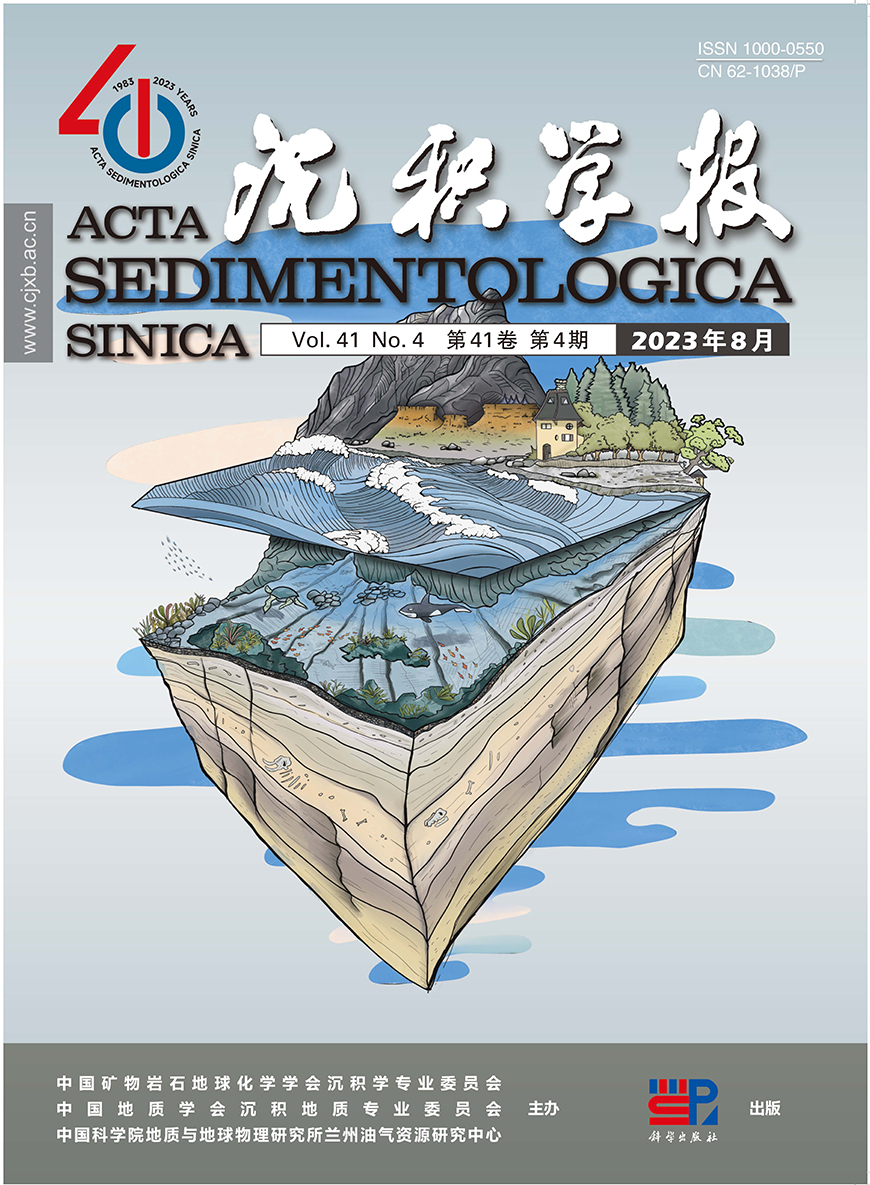


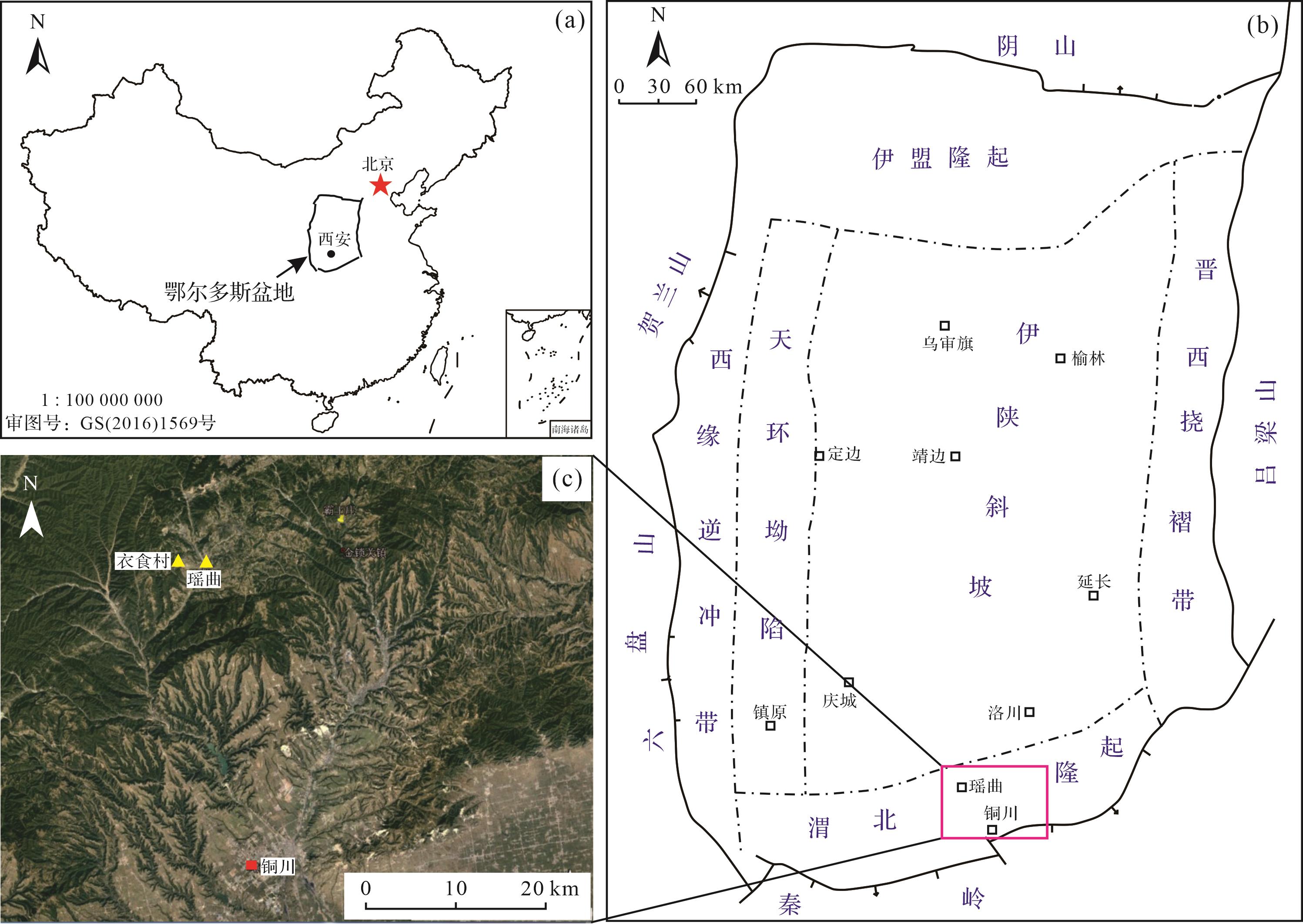





 DownLoad:
DownLoad:



